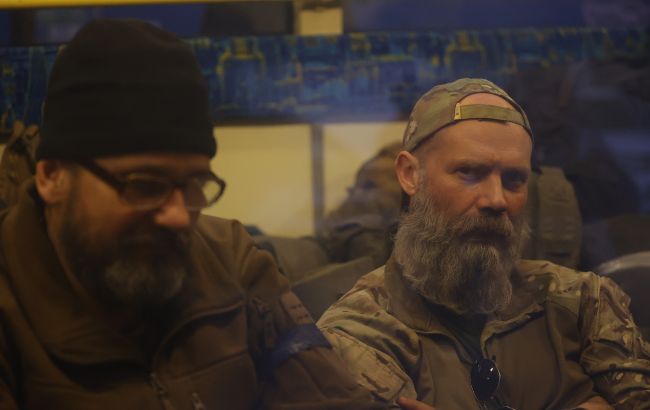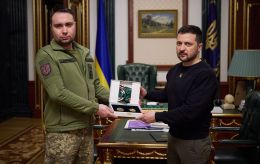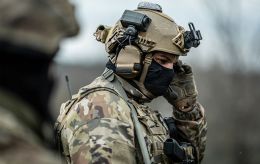Resilience unyielding: Mariupol's defenders stand firm one year after Azovstal

A year ago, Mariupol defenders had to take the painful decision to surrender and leave Azovstal. This tough call was made to safeguard the personnel's lives, an event that we explore in-depth in the RBC-Ukraine article below. This article encapsulates the tumultuous final weeks of defense, providing first hand military accounts, as well as analysis of the unfolding events.
A year ago, Mariupol defenders had to take the painful decision to surrender and leave Azovstal. This tough call was made to safeguard the personnel's lives, an event that we explore in-depth in the RBC-Ukraine article below. This article encapsulates the tumultuous final weeks of defense, providing first hand military accounts, as well as analysis of the unfolding events.
From the inception of the full-blown invasion, Russian forces targeted Mariupol relentlessly. The city was subjected to an incessant barrage of air assaults, transforming its once-bustling streets into a desolate war zone. The elimination of Mariupol from the map commenced immediately upon the invasion, with aircraft frequently targeting residential neighborhoods with half-ton bombs. A complete encirclement of the city took place by March 2, 2022.
The responsibility for Mariupol's defense was shouldered by a diverse group of Azov soldiers, marines, border guards, police, and other military units. As Russian forces gradually constricted their chokehold on the city, escape routes for the defenders began to diminish. By mid-April, a transformation occurred. The defense forces found themselves converging on Azovstal, a sizable steel plant, and refashioning it into a makeshift fortress.
Azovstal, the size of a small town in Ukraine, offers a myriad of buildings, bunkers, and underground passages. It served as a formidable fortress for several months while its brave defenders carried out nocturnal raids and provided protection to civilians who sought refuge in the bunkers. However, the enemy was relentless, employing a wide array of weaponry to target Azovstal, ranging from artillery fire to rocket launches, and even the deployment of FAB-1500s, in an attempt to demolish the solid walls of the Soviet-era bunkers.
The world was watching the dramatic defense of the plant by Ukrainian soldiers, who faced lessening supplies of food, water, and ammunition. Protests erupted across the globe, with demonstrators calling for the Russian dictator, Vladimir Putin, to provide a safe passage for the embattled Ukrainian soldiers. As mid-May approached, the evacuation of the wounded commenced, followed shortly by the civilians. The commanding officers, in a final act of defiance, were the last to vacate their stronghold, surrendering to the enemy with unyielding resolution.
Transfer to Azovstal
Soldier Ilya, known by his call sign "Smurf", was among the troops defending Mariupol. On April 14, he and his comrades were instructed to abandon their current locations and relocate to Azovstal. He recalled the perilous journey, stating, "At 3:00 a.m. on April 15, we began our journey towards Azovstal, navigating through a hailstorm of artillery, grenade launchers, drones, and flares. We were targeted from all directions, making the passage incredibly hard."
The ordeal intensified when an ATGM targeted their vehicle near a fish cannery, a stone's throw away from Azovstal. The impact catapulted Smurf out of the vehicle, knocking him unconscious. On regaining consciousness, he was met with a haunting scene - his mangled helmet, a crushed car roof, and wounded soldiers awaiting evacuation.
The team's dangerous journey to Azovstal took a dramatic turn when their vehicle was hit by an ATGM near a fish cannery across the river. The impact threw one of them out of the car, causing him to lose consciousness. When he woke, the sight that greeted him was one of chaos - a damaged helmet, a wrecked car, and injured comrades waiting to be evacuated.
He vividly recollected, "We grouped up with other fighters, struggling to reach our destination. We stumbled upon a house en route to the plant where we decided to hole up, given the heavy fire we were under. We spent the night there, with the encroaching Russians closing in on our position. We braced for them to storm our hideout, but we lucked out as they moved on."
By the dawn of the next day, they were left mulling over the safest passage to Azovstal. The decision was made to attempt a river crossing by swimming. Midway through their risky swim, the rumble of vehicles echoed around them. Spotting a Russian armored personnel carrier, they realized that a different choice of route would have landed them right in enemy territory.
"The river crossing was chaotic. Some had boats, others like us, were relying on sheer grit and muscle. I was hit by a cramp midstream and started to sink. Nobody could assist me - everyone was fighting their own battle against the current. Somehow, I managed to reach the other side, only to be met with a grim sight - a fallen soldier, naked and shot in the head. I alerted the guys that we needed to move," Ilya recounted.
Exhausted but undeterred after their swim, they embarked on a run for a kilometer and a half. All the while, enemy forces showered the area with Grad rockets. Fortune favored them once more as they managed to take refuge in a basement, narrowly escaping the deadly rain of shrapnel.
Soldiers at Azovstal (photo: Dmytro Kozatsky)
"I found my unit in the Azovstal bunker. Soon after, I was directed to relocate to the plant's periphery and assume defensive duties. A group of 8-10 of us held the line, barring Russian troops from infiltrating the plant," he said.
Recalling what they went through, Ilya spoke of the persistent attacks from air and artillery. The simple act of sourcing food and water often cost many of his comrades their lives. Dust engulfed the plant after each airstrike, making it nearly impossible to breathe. Every day, the grim conditions escalated, but the soldiers' resolve remained steadfast.
“Iron” and “Concrete”
Another soldier, Andriy, arrived at Azovstal on April 7, injured and brought in by boat. For the initial days, he was housed in a bunker aptly named "Zalizyaka" (“Iron” - transl.), reserved for the gravely wounded. "I was led to believe that an evacuation helicopter might be available. However, once I reached the bunker, I realized there was no helicopter," he confessed. “What I witnessed there was harrowing - soldiers with severe injuries, missing limbs. The pervasive stench of death was inescapable. I can't describe it, you smell it only once in your life. Yet you remember it forever.”
According to Andriy, the wounded were brought in allegedly for surgeries and then carried out in body bags. The constant confrontation with death and suffering took a heavy emotional toll on him. "While there were still food supplies, we had two meals a day - porridge, lard, cheese bits, and even a bucket of honey that everyone eagerly scooped from," he said.
Eventually, Andriy was moved to another bunker, "Beton" (“Concrete” - transl.), designated for the moderately and mildly injured. Although food was scarcer, the conditions were marginally better, with mats to sleep on and backpacks for pillows.
One particular memory stands out for Andriy. "One day I went for a walk and saw a four-year-old girl taking refuge in the bunker, amid the unending horror and death. I was taken aback by her presence there, considering the shelling that didn’t stop for a minute, causing the walls to crumble. I wondered how hard it was for her and what psychological toll it was taking on the young child," the man shared his memories.
Andriy also recalls the presence of Starlink connections in most bunkers, providing internet access to almost everyone. At one point, they started posting and sharing photographs taken against the bunker backdrop, an activity that inadvertently led to more precise attacks from the Russians.
A shell once struck the top of the bunker, directly hitting the makeshift kitchen set up there, taking the lives of everyone present. This incident marked the beginning of severe food shortages. "From that point on, we received a small cup of soup once a day, with some buckwheat or other form of porridge at the bottom. That was all we had," he recounts.
A soldier at Azovstal (photo: Dmytro Kozatskyi)
According to Andriy, he had to mentally adjust to the fact that it is real, we are at war. It was especially difficult for him in the early days. "I felt an overwhelming pressure, as if the very walls were closing in on me. Over time, I grew more accustomed to the situation," he said.
When Major Serhiy Volynsky, commander of the 36th Marine Battalion, recognized the impossibility of escaping Mariupol, he led his unit to Azovstal. After breaking through the encirclement at the Ilyich plant, they arrived at Azovstal. The details of Major Volynsky's actions while at the plant are still largely undisclosed, but it is certain that future books and films will depict his impressive feats. Some of the strategies he and his team executed will be remembered for their brilliant military ingenuity.
Major Volynsky became a topic of public conversation when he called for the withdrawal of the troops from the plant. As relentless bombing of Azovstal continued, the bunker sustained serious damage. Concrete slabs rained down on soldiers and civilians alike, causing fatalities. The Major's exhausted face would often appear across news platforms as he pleaded with the world to aid in the "extraction" of the Ukrainian military. "I call on the whole world, I call on everyone to help implement the extraction procedure for the Ukrainian military!" Serhiy wrote on social media.
In contrast to this public persona, Major Volynsky offered a more optimistic point of view to his relatives. His sister, Tetiana, recalls that his messages were short and reassuring.
"When Serhiy got in touch, those were very short and positive messages, like “Everything will be fine”, “Everything is ok”, etc. He did not tell us anything negative, did not share anything, but, of course, we knew about the reality," Tetiana said in a comment to RBC-Ukraine.
Despite the comforting messages, the grim news from the frontlines told a different story - the Russian forces had encircled the plant and incessantly bombarded it. The term "extraction" became ubiquitous, heard everywhere from Ukrainian cities to international platforms such as the Eurovision Song Contest, the United Nations, and Hollywood. The world took notice of Azovstal's defenders.
The decision to leave
According to the soldiers' recollections, a significant meeting took place on May 14th. All commanders were summoned by the Azov commander, Denis Prokopenko, known as "Redis," to discuss the situation with the president. Meanwhile, the soldiers anxiously awaited news, aware that holding Azovstal was becoming pointless given the scarce food and medical supplies.
The soldiers remember how the commander relayed the decision to them, "We are to be taken captive. This is not surrender but an order. We won't remain prisoners for long - a month or three at most. The Red Cross will oversee conditions."
The following day, Redis convened everyone in the bunker and outlined the plan, citing that the Red Cross was to be present during the exit and that proceedings would adhere to the Geneva Convention. An officer even printed out the Convention for the soldiers to peruse, reassuring them of their rights. However, the actual departure diverged significantly from these expectations.
Marine Artem Dyblenko notes that when the decision was made to leave Azovstal, they knew the situation couldn't continue as it was. "The guys were hesitant about surrendering, but the commander's order held sway. We wouldn't have considered surrendering without it. We were losing people every day. However, we trusted the leadership's plan. That was crucial. Everyone eventually agreed," he recalls in an interview with RBC-Ukraine.
Artem Dyblenko (photo: Dyblenko's Facebook page)
Leaving Azovstal
The soldiers were departing the Azovstal bunkers happened in batches, with the entire “extraction” process spanning five days. Ukrainian representatives were there to bid their farewells with a handshake. Following this, the Ukrainians handed their weapons and personal belongings over to the Russians.
"We were aware of their disdain for us, we knew not to trust them. Still, some officers clung to the belief that we would be treated decently. That naïveté didn't last long," says a soldier known by the call sign "Smurf".
When the final contingent of fighters departed, several dozen individuals chose to remain behind. Their subsequent fate remains unknown.
The soldiers recall their march away from Azovstal under the watchful eyes of armed Russians. "It was an uneasy feeling, laced with a sense of shame at leaving our post. The Russians found amusement in our retreat, laughing and calling us 'Nazis'," they said.
Numerous videos of the soldiers leaving the plant began to appear on the Internet. The defenders kept calm and looked their enemies straight in the face. Marine Artem Dyblenko was part of the final batch that left on the fifth day. In one such video, Artem is seen calmly approaching an armed occupier wearing a balaclava. He places his belongings down in front of him, then stands upright, his gaze steady as he faces the occupying soldier.
Leaving Azovstal (photo: Getty Images)
As he recalls, the Russians exhibited a range of attitudes—there was no clear coordination in their behavior.
Artem Dyblenko recounts, "A few merely observed from the sidelines, completely indifferent, while others were bold, taking anything they could from what we had decided to leave behind—a bar of soap, shampoo, canned food—they threw everything out. They didn't seem to have clear directives—some were notably aggressive, taking everything, whereas others were somewhat lenient. There was a diverse array of attitudes. I, for one, was left with nothing due to the whims of the one who dealt with me."
He adds that fear was not a prevailing feeling, but rather accomplishment. "We put them through a great deal," he declares.
Tetiana Volynska, who had been keeping track of her loved one's plight through news updates, informs us that she first heard of the extraction procedure on May 16th, when the evacuation of the wounded was being organized.
"When the military started to slowly vacate the Azovstal plant on May 17th, we began to comprehend the full extent of the situation. Serhiy didn't explain any specifics, his constant reassurance was “everything will be okay”. When probed about what the future held, he would state that he would live. That's as far as he went," Tetiana reflects.
Azovstal soldiers in buses (photo: Getty Images)
As the exit unfolded, the invaders turned their cameras towards Serhiy, capturing his every move on video. Given the considerable notoriety Volynskyi had accrued during his tenure at Azovstal, their focus on him was expected. Subsequently, while in captivity, Serhiy would find himself the subject of several more videos crafted by the Russians. He would respond in clipped phrases to the derisive questions posed by their propagandists.
Captivity
Once the soldiers were onboard the bus, representatives of the Red Cross arrived. Their task was to distribute forms for the soldiers to fill out - critical information about the captives. However, before they could complete this task, Russian soldiers aggressively ushered them out.
The soldiers' journey ended at a prison in Olenivka. This facility housed them in barracks, 500 people in each, 100 people per floor. There were no beds. Their sleep was confined to the hard floor.
One soldier recalls, "The building we were in wasn't fully equipped. Some parts lacked basic amenities like glass windows. Of all the barracks, the first one was the most decent, hosting the guys from Azov. That's the one they displayed when the Red Cross came for inspection. Requests to view the other barracks were flatly rejected by the Russians."
Federal Security Service interrogations followed, and select lists were drawn up. Smurf, one of the soldiers, recalls a particular night. "We were woken in the middle of the night, names were called out, and we were told that these were lists for exchange. A week after leaving Azovstal, I found this peculiar. The ones called were bundled into Kamaz trucks and transported to Russia."
Marine Artem Dyblenko recalls a similar trajectory, his journey starting in Olenivka and later shifting to Taganrog. He only spent a few days in the Donetsk region, as did most of his comrades. Following a series of explosions in Colony No. 120 on July 28-29, news trickled out that 53 prisoners of war had tragically drowned. The aggressors predictably blamed the Ukrainian Armed Forces for the atrocity.
Dyblenko speaks shortly about his time in captivity. His requests for books were continuously met with violence. "They even denied me a Bible. For two months, there was no soap in the cell, not to mention other personal hygiene items."
Tetiana, a sister to one of the captive soldiers, Serhiy, is unable to share about her brother's captivity experiences. The Russians flouted the Geneva Convention, human rights, Red Cross standards, and common sense by denying him contact with his family.
Tetiana recalls, "We constantly emphasized the norms of the Convention, we kept in touch with the Red Cross, they saw the videos, they noticed Serhiy's bruises, but no one could do anything. They only made promises."
Most soldiers prefer to remain silent about their experiences in captivity. It remains challenging to piece together their stories. The Russian captors employed all possible tactics to break the spirit of Ukrainian soldiers. Despite this, a common thread ran through their stories of Azovstal and captivity - a shared hope for an exchange. Some have seen this hope come true as periodic exchanges between Ukraine and Russia occur. The most significant exchange happened on September 21, with many defenders of Azovstal returning home. Commanders were also released, but they were immediately transported to Turkey where they remain for now.
Hundreds of defenders still yearn to see the Ukrainian flag on their homeland border. Trapped within the chilling confines of the prison, the soldiers of Mariupol await their moment of freedom.

